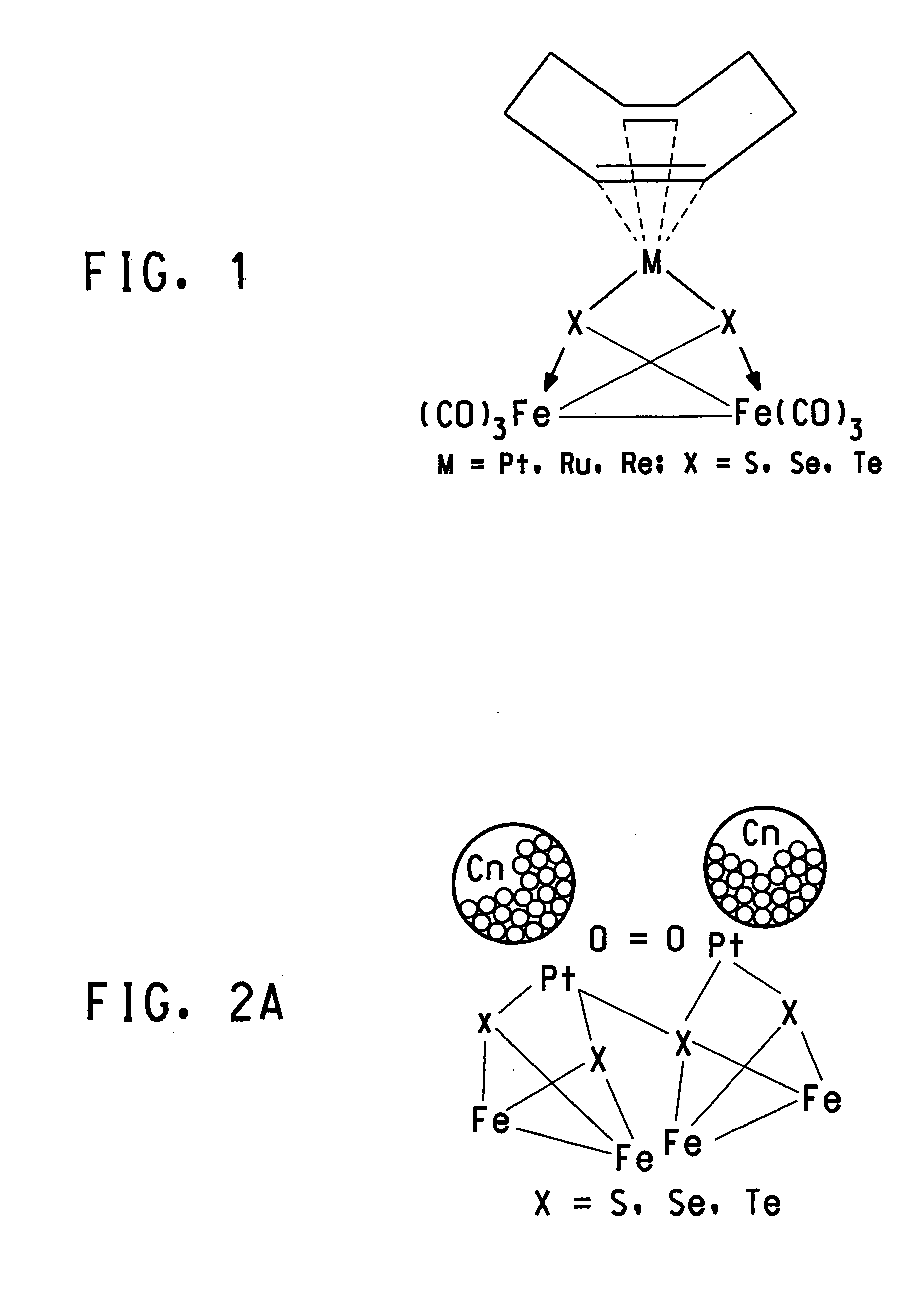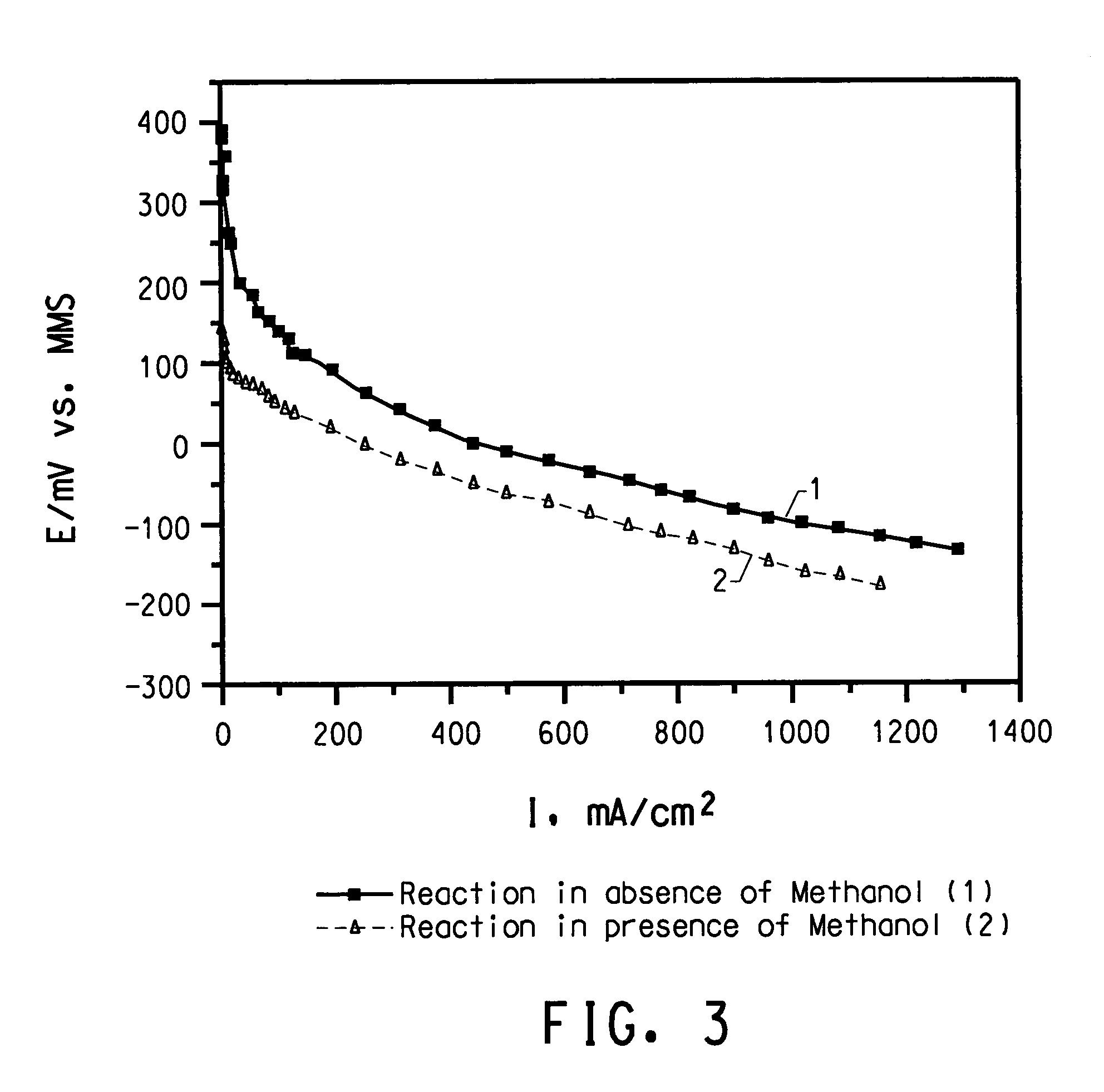Methanol tolerant catalyst material
a catalyst material and methanol technology, applied in the field of catalysts, can solve the problems of serious storage and transportation problems, undesirable crossover of reactant from one electrode to the other, and decrease in both reactant utilization efficiency and fuel cell performance, and achieve long-term stability, high catalytic oxygen reduction activity, and composition. good
- Summary
- Abstract
- Description
- Claims
- Application Information
AI Technical Summary
Benefits of technology
Problems solved by technology
Method used
Image
Examples
example 1
[0065] The powder of Ketjen® black (66 mg) was soaked under Ar with solutions of aforedescribed cluster (CO)6Fe2S2Pt(C10H12) (1) ( 47 mg) in 10 ml of tetrahydrofuran and dried in vacuum. The quantity of the cluster was calculated to obtain active supported catalyst with correlation catalyst: support of 1:2. After that the powder was heated in an Ar stream at 200° C. for 2 hours and cooled in Ar atmosphere. In the separate experiments by the differential scanning calorimetry (DSC) were shown that thermolysis of the clusters begins at a temperature about 100° C. and then, at a temperature about 140° C. the elimination of cyclic hydrocarbon ligands, namely dicyclopentadiene or cyclooctadiene takes place. Finally, at a temperature 175° C., most of CO ligands are lost. The final product of thermolyses had the composition Fe2PtS2C2O2.
[0066] The redox behavior of catalyst based on (1) is presented in FIG. 9. FIG. 9 shows a cyclic voltamagraph (CV) recorded at the electrode with freshly pr...
example 2
[0068] The powder of Ketjen® black (66 mg) was soaked under Ar with solutions of aforedescribed (CO)6Fe2Se2Pt(C10H12) (2) (48.5 mg) in 10 ml of tetrahydrofuran and dried in vacuum. The quantity of cluster was calculated to obtain active supported catalyst with correlation catalyst: support as 1:2. After that the powder was heated in an Ar stream at 200° C. for 2 hours and cooled in Ar atmosphere. The final product of thermolyses had the composition Fe2PtSe2C2O2.
[0069] The redox behavior of catalyst based on (2) is presented in FIG. 10. FIG. 10 shows the CV recorded at the electrode with freshly prepared Pt—Fe—Se catalyst and the CV was recorded in 2.5 M H2SO4. One can note some decrease in the degree of reversibility of the redox process in comparison with the catalyst based on (1). However, the nature of the process is the same and ascribed to the valency altering of iron atoms.
[0070] The catalytic activity of this catalyst was evaluated on a gas-diffusion electrode in oxygen sat...
example 3
[0071] The powder of Ketjen® black (66 mg) was soaked under Ar with solutions of aforedescribed cluster (COD)Pt(μ3-Te)2Fe2(CO)6 (5) ( 44.7 mg) in 10 ml of tetrahydrofuran and dried in vacuum. The quantity of cluster was calculated to obtain supported catalyst with correlation catalyst: support as 1:2. After that the powder was heated in an Ar stream at 200° C. for 2 hours and cooled in Ar atmosphere. The final product of thermolyses had the composition Fe2PtTe2C2O2.
[0072] The redox behavior of catalyst based on (5) presented in FIG. 11 shows CV for freshly prepared electrode with Pt—Fe—Te catalyst. This CV is typical for irreversible processes. One anodic but three cathodic peaks can be seen at the CV with rather high difference between potential of anodic and corresponding cathodic peaks.
[0073] Examination of FIGS. 9-11 reveals a good correlation between redox behavior of diene-bis(tricarbonyl) clusters of Pt—Fe-chalcogenides (CVs on glassy carbon electrode in CH2Cl2 with Bu4NPF6...
PUM
| Property | Measurement | Unit |
|---|---|---|
| Temperature | aaaaa | aaaaa |
| Temperature | aaaaa | aaaaa |
| Time | aaaaa | aaaaa |
Abstract
Description
Claims
Application Information
 Login to View More
Login to View More - R&D
- Intellectual Property
- Life Sciences
- Materials
- Tech Scout
- Unparalleled Data Quality
- Higher Quality Content
- 60% Fewer Hallucinations
Browse by: Latest US Patents, China's latest patents, Technical Efficacy Thesaurus, Application Domain, Technology Topic, Popular Technical Reports.
© 2025 PatSnap. All rights reserved.Legal|Privacy policy|Modern Slavery Act Transparency Statement|Sitemap|About US| Contact US: help@patsnap.com



